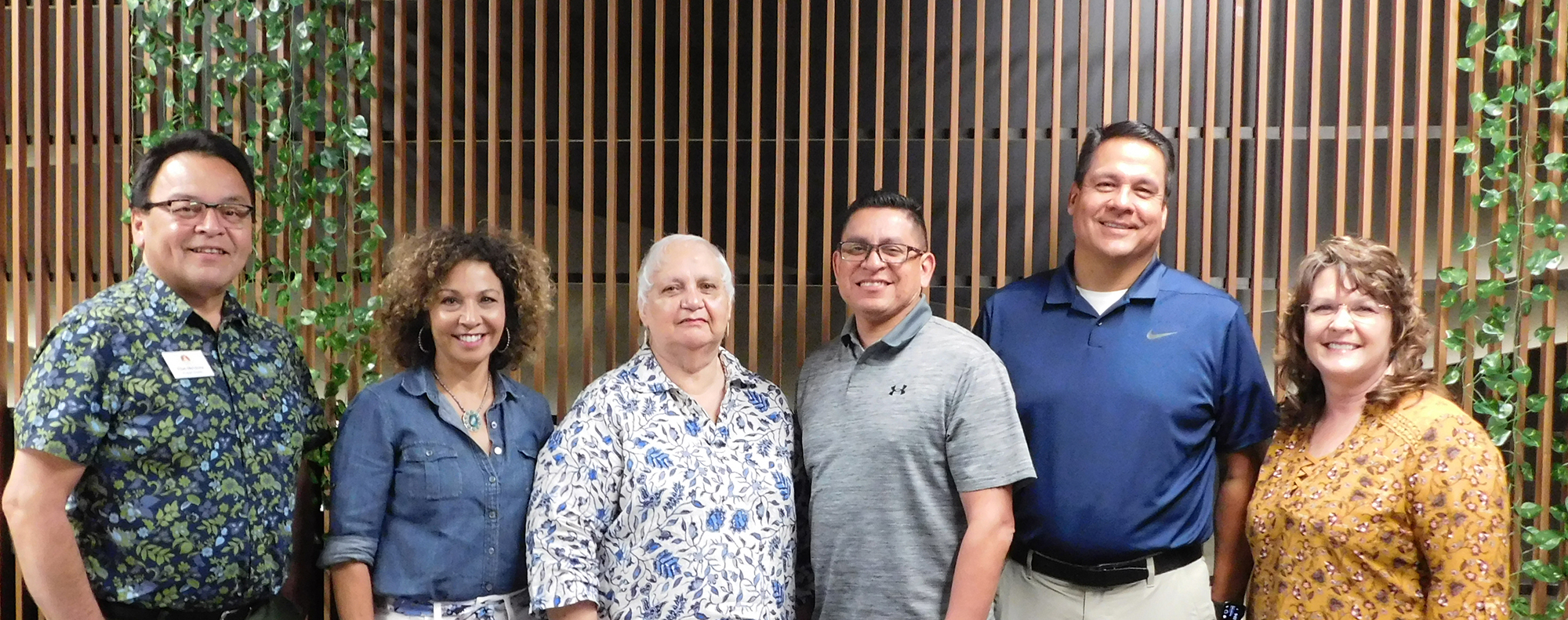Eric Shepherd, Vice Chairman

Eric Shepherd (third from right) was seated on the South Dakota Native Homeownership Coalition’s inaugural Board of Directors in June 2022. He serves as the Vice Chairman and is the Executive Director of Sisseton Wahpeton Housing Authority.
A New Vision
Eric took the helm of the Sisseton Wahpeton Housing Authority as Executive Director in August of 2018 and has been working to transform the traditional housing authority paradigm in his community since then. Stepping into this position at a time when most tribal homes are nearing the end of their life span, he saw a need for revitalization – not only for the physical structures, but also for the vision of the organization.
“Materials have changed over the years. Our ancestors had to make do with what they had, and that worked for them at that time. We acknowledge those efforts and know that everything we have now is because of what they did. Today, we carry on that legacy by assessing and reevaluating and keep improving,” says Eric.
In less than five years under his leadership, with a commitment from tribal council to support new housing construction, SWHA his built 57 new homes. Rather than building homes to last the standard 20-30 years, they are taking a 50-year approach to embed resiliency into the physical infrastructure of their community. To support this strategy, Eric says his team’s motto is “built tight and ventilated right.” Under the Tribe’s development plan, SWHA will be building several scattered sites over the next 10 years.
Developing a Workforce
These accomplishments have not come without challenges, though. There is a huge age gap in the Sisseton area’s skilled labor force, which strains the efficiencies and productivity levels of SWHA’s construction teams.
“We had an awesome workforce back in the day,” says Eric. He explains that as Indian gaming gained momentum, more tribal members sought out those jobs. As a result, the trades workforce shrank.
While the majority of SWHA’s labor is over 50 years of age, there is a small but growing trend of 20-somethings entering the building trades. This is partially due to SWHA’s involvement in the South Dakota Native Homeownership Coalition’s Construction Internship Program. Through that program, about 20 young tribal members have gained hands-on experience in residential home building and about 10 have obtained full-time employment in the construction sector. With workforce development as one of SWHA’s top priorities, they have approached this issue holistically by engaging several other tribal departments. The result of this collaboration has been an integrated road map to building their local workforce.
“I am super proud of my team for taking on those tasks and wearing different hats,” says Eric.
Changing Perspectives
Another challenge that Eric is consistently navigating at SWHA is the astronomically high demand for low-income rental housing. Eric has spearheaded the development of a revolutionary, data-driven program to alleviate that demand by creating pathways to affordable homeownership. Based on income brackets, the program has placed 20 previous renters into new lease-to-own units. Through the leasing period, tenants will be investing into a tangible asset and building skills to successfully take on homeownership.
“We have the entry points for housing options, but this is an exit plan based on self-sufficiency,” proclaims Eric.
The program, currently in its first year, is changing the community’s perspectives surrounding tribal housing. This new view embraces low-income rental units as transition points, rather than permanent dwellings. By moving tenants through low-income units, versus into them, SWHA will be able to lower demand for tribal housing to a more manageable pace while creating opportunities for economic advancement for everyone.
In another step outside of the traditional housing authority box, Eric and his team are creating a handful of Limited Liability Companies (LLCs). One of these entities will include the renovation of an existing hotel to capture more tourism dollars flowing through the state. The idea behind these for-profit entities is to generate income that will support SWHA’s self-sufficiency and decrease reliance on the federal government.
“We’re changing the perspective of what ‘housing authority’ means,” he explains.
Leaving a Legacy
As a champion fancy dancer, competing in almost every state across the country, Eric has seen a lot of Indian Country. From the time he was a young boy, Eric remembers his elders impressing upon him that he was a descendant of strong tribal leaders and that he should carry his heritage in a proud way. Eric knew that his great, great grandfather was one of the first chairmen of the Sisseton Wahpeton Oyate and that other relatives had served in various tribal leadership capacities. But, he grew up in an urban area of Southern California and didn’t fully grasp the meaning of those lessons from his elders until later in life when he moved home to the Lake Traverse Reservation.
This broad range of varied experiences have shaped his unique perspectives and approaches to his work today. As a father of six, he takes a longer view. He isn’t just fulfilling immediate needs for shelter, but he is also developing housing for future generations. His belief that everyone should be able to grow up in a safe and affordable home is a driving force that keeps him going every day. It was also part of what inspired him to become part of the Coalition. He wanted to be a voice for the region and to reach tribal communities across the nation so they could also leave a legacy of homeownership.
His foundational message, “You can do a lot more with your housing authority. It’s doesn’t have to be just what we’ve always done.”
